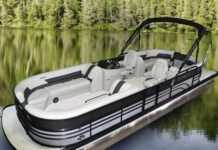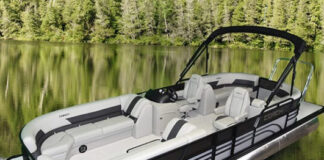What do we mean with hydrofoil? We define hydrofoil a lifting surface – also called foil – that operates in water. The hydrofoil look, in fact, is very similar to aircraft airfoils. The physical operation is similar as well and it is subjected to fluid-dynamics and hydrodynamics laws. When the speed of the means on which it is mounted increases, the hydrofoil generates a thrust that is equal to the means’ weight – generally a boat but it is used on surfs or kites, too – pushing the hull out of water, in this way notably decreasing friction and then enabling higher speed. The advantage? More efficiency and a decrease of the fuel use, even up to 35% for motors; concerning surfs or kites, the possibility of reaching high speeds even with low waves or moderate winds.
Today the electric is trying to make its way also in the yachting sector but making fast electric boats is very difficult. To overcome the water friction, conventional hulls need enormous batteries to reach higher speeds. However, this increases their weight and cost, without anyway rising their speed proportionally, then standard electric boats have much lower autonomy than fossil-fuel competitors. For this reason, the Swedish electric Candela C-7 speedboat has been equipped with a hydrofoil and now it “imitates aircrafts to fly above the water”, reducing friction and finally permitting long electric autonomy at sea. This makes Candela C-7 the first electric boat in the world that combines long-range autonomy and high speed. The 6-passenger daycruiser flies above waves at a speed of 30 knots, using very little energy from its 40-kWh battery.
Hydrofoil is the secret of its efficiency indeed. The two-winged hydrofoil, combined with state-of-the-art computers, software and sensors, at speeds exceeding 14 knots, supplies a sufficient lift to lift the hull above the water, reducing the water friction by 80%. This allows an autonomy of 50 nautical miles at 22 knots, which is three-time higher than any other fast electric boat on the market.
If you combine the hydrofoil technology with state-of-the-art computerized control technologies, then the result is even more astonishing. In Candela C-7, for instance, the hydrofoil is adjusted by a computer resembling flight controllers used in modern fighter aircrafts. Hydrofoils are automatically regulated 100 times per second to assure stability. The result is an extremely smooth and completely silent ride, even in presence of wind and waves. Due to the efficiency of foils and to the aerodynamic electric propulsion unit, the operation cost of a C-7 is 95%-lower than a conventional fossil-fuel boat. At a cruise speed of 20 knots, the energy consumption per nautical mile is just 0.8 kWh, the equivalent of 0.2 litres of petrol. Hydrofoil is really a technology that can make the electric pleasure boating competitive.



